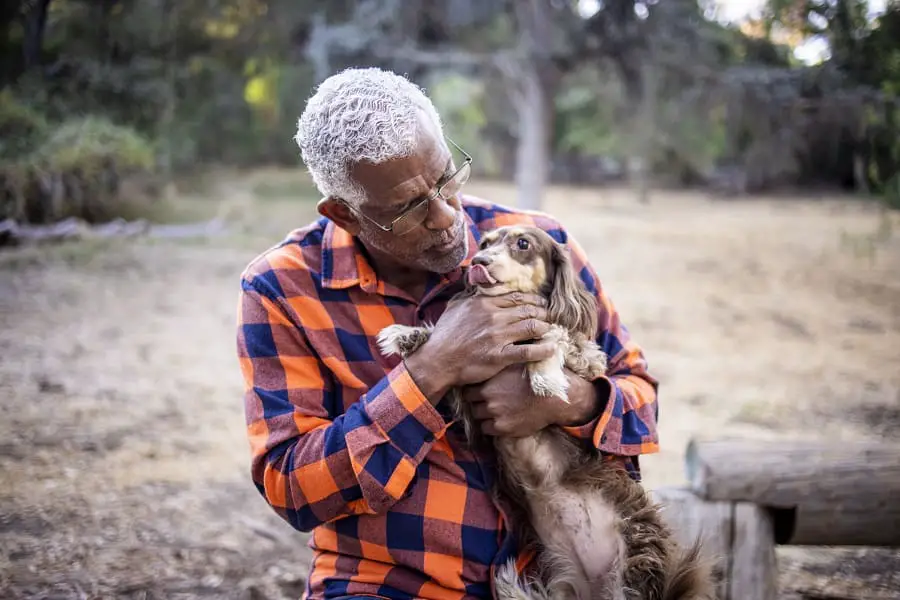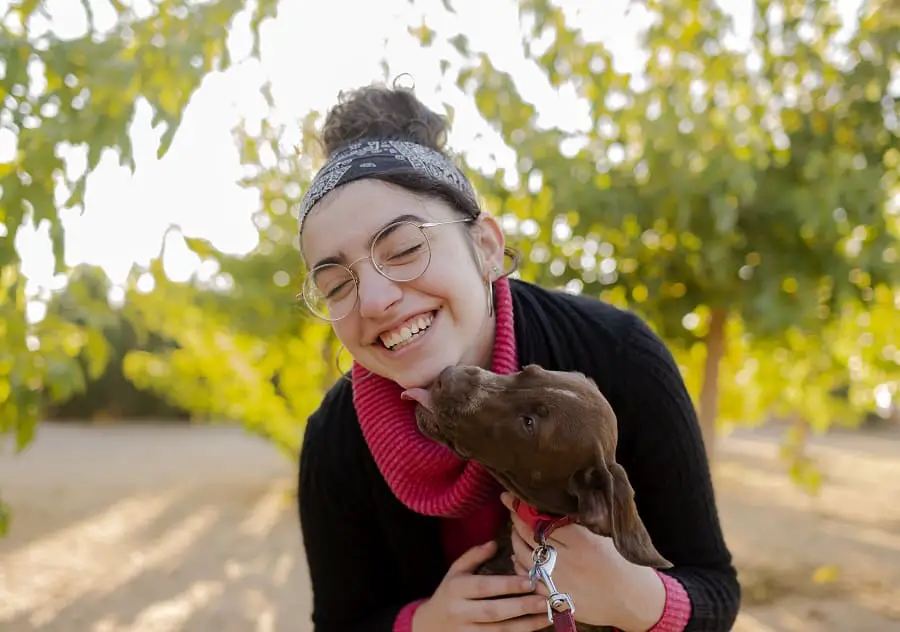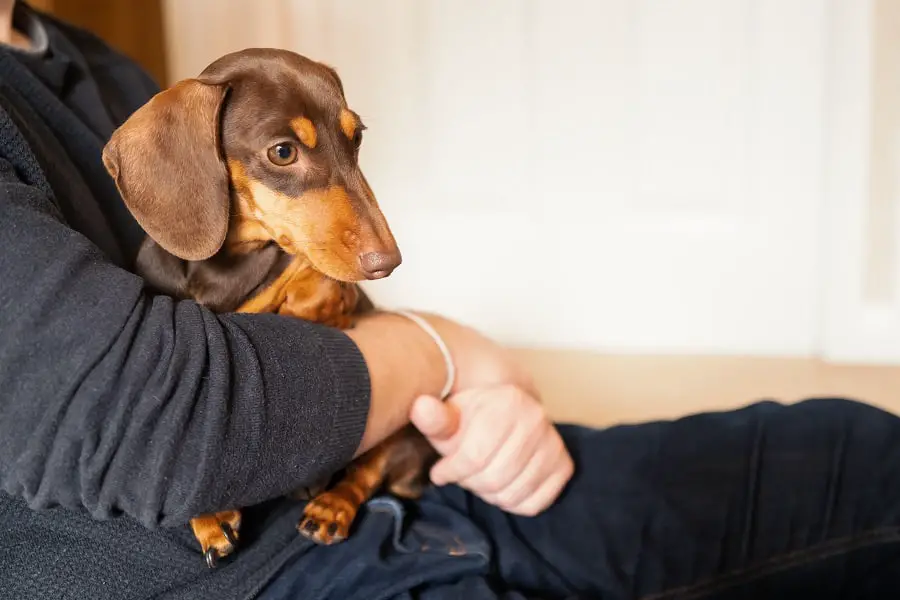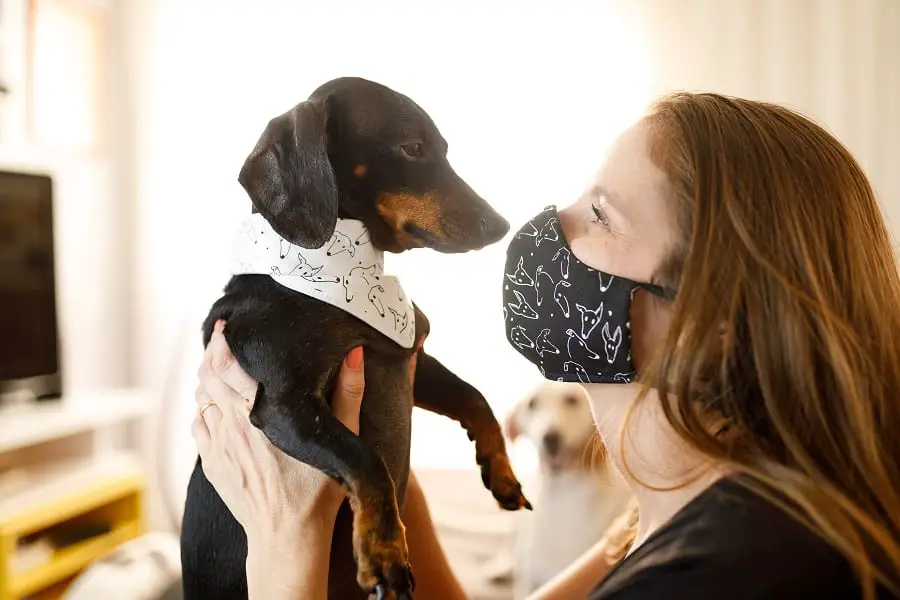Chances are, you’ve stared into your doxies sweet, silly face and wondered ‘What are they thinking about? Do they know I’m someone who cares about them?’ You’re definitely not alone.
One time or another, everyone wonders if their pet knows that they’re loved, and it’s normal to wonder if they love you.
Never fear, there are plenty of non-verbal ways that the affectionate Dachshund breed lets you know that they love you. Let’s count the ways, shall we?

Read on, and you’ll discover some key signs that your Dachshund thinks you’re all that and a bag of chips. You’ll also find some tips for understanding the difference in human emotions and doxie emotions.
A quick note:
Understand that it is normal for a doxie to bond with one specific person in your family. If this lucky individual isn’t you, it doesn’t mean that they don’t love you.
Trust is very important, and this individual could have been perceived by your doxie as the first person to show them love and affection.
It may even have been as simple as this individual being the first one to feed them. Typically this strong imprinting period occurs between birth and 6 months of age.
If your doxie is a rescue, the imprinting might be just because this individual was the first one to bring them home and give them the loving environment they deserve.
This give and take attitude will be a key dynamic that will be touched on a bit further down.
Don’t take offense if it’s not you, it’s just that doxies are extremely loyal and have a pack mentality. It’s likely that they see this person as the master or the alpha.
This doesn’t mean that they don’t have room in their silly hearts for more family members.
Whether the bonded individual is you or another family member, remember to always treat your doxie with affection and respect and they will know you as someone who loves them.
1) Face Licking
It might seem silly, but face licking is a massive sign of sausage dog love.
The rather disgusting origin of this practice is in centuries past, when adult doxie mothers would join their aristocratic masters hunting. When the mommas returned, the puppies would greet them by licking at their mouths.

This was a hopeful (and revolting) way of lapping up any regurgitated food from the adult doxie’s mouth. Of course, at this delicate age they were weaning. This was a way to encourage the pups to start eating solid food.
Grossed out yet? Yeah, me too. However, as gross as it is, there’s a reason behind this behaviour. It’s thought that licking (specifically at the mouth and ears) was taken as a sign of respect, submission and acknowledgement of the master dog.
The master dog, in this particular case, is usually you. Hopefully they aren’t licking your face for any leftover food though!
2) Bed Sharing
Oh yes, the inevitable Sharing of the Bed. Well, really, it’s noted in your Dachshund ownership manual that your sausage automatically owns every comfortable surface in your home, including your bed! Sorry, those are the rules.

Picture this, it’s been a long day and you’re finally falling into bed. A true sign of doxie love is when they make themselves quite comfortable with you in bed. Sometimes they’ll sprawl out, giving you just a sliver of room.
Sometimes they will snuggle right up against your back, enjoying the closeness and the body heat. Or they’ll fondly place their head on your arm or leg, making sure you know that they’re close by and vice versa.
3) It’s Party Time When You’re Home from Work!
This might be a universal dog thing, but another sign of sausage love is jumping for joy when you come home.
Complete with a wagging tail (another clear sign of love and affection) and maybe they’ll even bring their favorite toy for you to throw. I don’t know about you, but for me, that’s the best feeling in the world.
4) Physical Signs & Facial Movement
While this may seem like a no brainer, eye contact is extremely important. It’s thought that when your Dachshund stares into your eyes in a relaxed manner that it’s releasing a hormone known as oxytocin (the cuddle hormone). This serves to bond them even closer to you.

Another one is sitting on you, oddly enough. While this can also be a sign of marking their territory or jealous behavior, it’s a very cozy position for them. It can also mean that they are protective of you.
They also might want a snuggle or head scratch (do oblige). More interesting physical signs are eyebrow raising and ear movement.
Funnily enough, specifically in Dachshunds there’s the tendency to raise the left eyebrow/move the left ear back when met with people, toys and other dogs that they love.
When met with people they don’t know their expression is generally neutral. If they see a person or dog that they dislike, they tend to raise the right eyebrow or move the right ear back, especially when stressed or displeased.
This is a more minute sign, but as you get to know your doxie more and observe their patterns of behavior, you’ll see their own specific facial tics and quirks.
5) Bringing Toys
Doxies of yore were bred to be skilled hunters. Chasing after foxes, badgers and rabbits. They were of course rewarded in various ways and likely felt some sort of doggy pride that they fulfilled this task for their masters.
Bringing you a toy is a show of affection in the sense that they want you to play with them but also because they want to show you respect and acknowledge you as the senior ‘dog’ or their master.
Dogs & Emotions
Dogs and emotions can be a complex and frankly, a not wholly understood concept. We as humans tend to place human characteristics and emotions onto our dogs in order to relate to them and try to understand their behaviors.
This isn’t always the most effective method. The thing is, dogs don’t understand and experience complex concepts like remorse, pride or guilt in the same way we do.
These are more intricate emotions that require introspection, self evaluation and a clear understanding of right and wrong.
If you see your doxie beside a bathroom accident on the floor or after getting into the garbage lowering their little head and averting their gaze, it’s more to avoid conflict and show submission because they see your distress at the mess — not because they’ve reflected on their mess for hours and regret it!
Love is another quandary for pet owners. However, affection for another being isn’t as complex as the emotion of guilt, for example.
It can be as primal as being in the same family unit, you being the person to feed and care for your doxie, and your sausage showing you affection (like cuddles!) and having fun playtime in return.
It is thought, however, that most dogs in a good environment do develop genuine feelings of what we humans might term as ‘love’ for their owners.
This goes beyond the exchange of food and shelter for cuddles; most healthy and well adjusted dogs genuinely want to be around their human and have that positive contact and connection with them.
Separation Anxiety vs. Love
It’s important to look out for signs of actual anxiety and separation anxiety and be careful about terming it ‘love’. The lines can be blurred, of course.
Some signs include excessive barking, meltdowns when you leave the home, aggression with other dogs, following you around incessantly (more than the typical doxie would), and destruction of furniture/household items.

If anxiety is an issue, ensure there’s plenty of physical activity for your doxie and that they are not left alone for hours on end. Ensure they have a clean and happy area for them to hang out while you’re gone.
Perhaps put on a nature show to watch and leave plenty of toys for distraction. Trust is paramount for any dog, so make sure that you leaving the house is not made a big deal of, and calmly correct anxious behavior as often as you can.
Cuddling? Yes Please.
Cuddling with a doxie is beneficial for both parties, of course, due to the release of oxytocin and the positive bond that it reinforces. Doxies are generally cuddly dogs, as they enjoy the heat you give off and they have a tendency to be clingy.
Chances are, you’ll already have a good sense of if your doxie loves you or not by your home environment and your relationship with them. Remember to always treat your little Dachshund with affection, respect and plenty of fun.
They will soon move past the more ‘transactional’ affection of food and shelter resulting in cuddles for you, the master, to a more genuine loving attitude toward you and a want to be by your side at all times–even if there’s no food involved!
